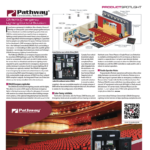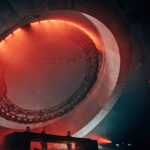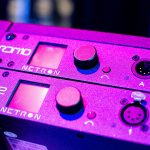There’s a fascinating book called The Big Switch: Rewiring the World, from Edison to Google by Nicholas Carr about how cloud computing is changing the world. In the production world, Remote Device Management (RDM) is changing the lighting industry. Martin RADAR makes use of both technologies and has the potential to change the way you configure and manage your lights.
RADAR, or Remote Access Diagnostics and Reporting, is a fixture configuration tool and information feedback system that gathers lighting fixture data remotely and sends it to you or anyone else on the system who has access. It allows operators and technicians to set up and monitor any RDM device like a system of lights, fog machines, color scrollers, or other related gear from anywhere in the world and take action in the event that it needs attention. Martin has ambitious plans for using this new tool as the basis for what they call “Complete Care.” The approach involves a planned service and maintenance arrangement whereby customers can complete a “clean software upgrade” on Martin legacy products, closely monitor installations remotely, and and improve the ROI on their gear.
The system was developed jointly by Martin with Wybron, the Colorado Springs-based scroller manufacturer, and it uses Wybron’s Infogate and Infostore technology systems. The Infogate Gateway is the hardware interface between RDM-enabled devices, the controller and computers running Infogate Software, which will run on any PC, Mac, or Linux-based computer. The gateway is a freestanding box about 8 inches by 3.7 inches by 9.8 inches with two DMX512 universes of input and output and an RJ-45 jack for Ethernet connectivity. On the front panel there is a 3-inch-by-3-inch LCD display, a Page button, and several LED indicators.
The gateway accepts a DMX512 input from a console and outputs it to a DMX512 network on which lights and other devices are connected. A router connects through the Ethernet connector on the gateway to one or more computers. In order for the system to work as intended, each device on the network should be RDM-enabled, meaning that it has firmware to run ANSI E1.20: Remote Device Management Over DMX512 Networks. Martin’s new fixtures, starting with the MAC III Profile, are already RDM-enabled and a number of their legacy fixtures can be upgraded to become RDM enabled. Those devices on the network which are not RDM enabled can still receive DMX512 and operate normally but they can’t report back to the controller, Infogate, or Infostore, nor can you remotely configure or monitor them.
In the software you’ll find the tools that allow you to automatically discover all of the RDM-enabled devices on the network and configure them using the Device Parameter Spreadsheet. Every RDM-enabled device is assigned a unique identifier (UID) which contains the manufacturer ID and an electronic serial number, something like a machine access code (MAC address) in a computer. The Device Parameter Spreadsheet pulls certain information from the fixture during the discover process and allows you to perform certain housekeeping tasks. For example, you can label each device, set its DMX512 address, assign a position and unit number and monitor such information as its temperature (provided it has temperature sensors), voltage, lamp hours, hours of operation and more. It then monitors all of the equipment and displays warnings and error messages in the event of a problem or potential problem.
The RADAR system is a cloud computing part of the equation. It is an Internet-based application that stores the information gathered by the hardware part of the system. It provides connectivity from anywhere in the world to any system on the RADAR. On the home page you’ll find a list of each installation and a world map pinpointing its location. The list contains a timestamp, a status message, and the severity of the status message. The interactive world map is powered by Yahoo and it allows you to zoom in to any location.
The severity of the message can be either an advisory, a warning, or it can be an error message. An advisory message is when something is not configured correctly but the device is still functional, for example, when a door is open on a MAC 2000. A warning is a more severe case, for example, when an error message of undetermined nature is reported. That means the device may or may not be functioning correctly. And an error message is when something is likely amiss and not functioning properly, for example, a lamp or a sensor fails. It gives you the option to display only those messages which have not yet been acknowledged or all messages since the beginning of time.
If you click on an installation it provides more detailed information about the gear and its status, including its location, the time of the last report, any messages associated with specific gear and a gear list that can be expanded or collapsed. If you expand the gear list and select a particular fixture it will give you specifics about it, including its UID, label, position, unit number, DMX512 address, DMX footprint (how many DMX512 slots it uses), the RDM version number, its personality setting, sensor reading and more.
When the Controls Protocols Working Group of ESTA was developing the RDM protocol, the litmus test for each portion of the standard was, “Is it faster than a tech on a ladder?” If the answer was yes, then they left it or included it in the document. In the case of Martin RADAR, not only is it faster than a tech on a ladder but it’s much, much faster than a tech on a plane dispatched to a remote installation. With RADAR, the installation can be globally monitored 24 hours a day via the Web from any office to any site, and many problems can be avoided by addressing them before they disable a piece of gear. And by keeping records of the status of each device on the network the customer can better analyze the performance of the gear and Martin can use the data to improve their products. Martin intends to enter into a contract after commissioning a new system whereby the system is cleaned, calibrated and maintained and the user is further educated about the system. The idea is to minimize downtime, increase the life of the equipment, and and realize a greater resale value for the gear. For more information about the program, visit the Martin Web site at www.martinpro.com.
In the future, it would be ideal to incorporate the software into a console so that FOH is not cluttered even more than it already can be. When the programmer/operator can access this information on the same console she is using to program the lights then the implementation will be complete. Until then, it’s a small price to pay for a major step forward.


